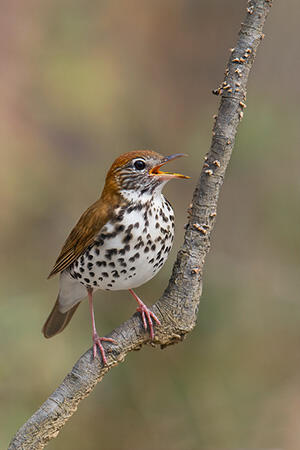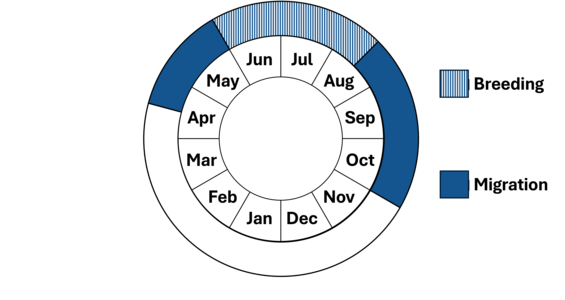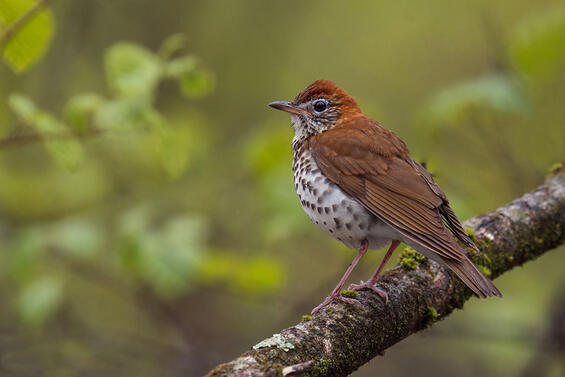- Scientific name: Hylocichla mustelina
Species of Greatest Conservation Need (MA State Wildlife Action Plan)
Description

Wood thrush (Hylocichla mustelina)
The wood thrush is the largest woodland thrush in New England, known to many admirers for its flute-like song. It is a medium-sized (8 inches in length) migratory songbird, similar in posture to the American Robin but smaller in size. Male and female plumage is similar and include a brown crown, nape, back, wings, and tail. The underparts are white with conspicuous black spots on the breast and sides. Adults have a white eye-ring and pinkish legs. Juvenile plumage is similar but with tawny spots on the back and wing coverts.
Life cycle and behavior
Wood thrushes arrive in Massachusetts in late April to early May, establishing breeding territories in mature forests. The breeding season extends from May through July, during which time females build compact, cup-shaped nests in shrubs or small trees, typically less than six meters from the ground. Clutch size is usually three to four eggs, with an incubation period of about 12–14 days. Both parents participate in feeding nestlings, which fledge after approximately 12–15 days.
Following the breeding season, wood thrushes shift their diet from soil invertebrates to include more lipid-rich fruit (e.g., dogwoods, viburnams), which help fuel their migration. They depart for Central America in late summer or early fall, wintering primarily in the tropical forests of Mexico and Central America. This species is highly territorial during the breeding season but may form loose foraging groups in winter.

Population status
Although the wood thrush is not listed under the Massachusetts Endangered Species Act, their population is in decline across its range, including Massachusetts. The North American Breeding Bird Survey recorded an annual population decline of –1.3% from 1966 to 2019, resulting in an overall population loss of around 50%. This downward trend is thought to be primarily due to habitat fragmentation and degradation in both breeding and wintering areas.

Wood thrush (Hylocichla mustelina)
Distribution and abundance
The wood thrush breeds throughout the eastern United States and southeastern Canada, with its highest densities found in the deciduous forests of the Midwest and Northeast. While still considered a fairly common breeder across Massachusetts, wood thrushes are rare on Cape Cod and absent from Nantucket. In Massachusetts, wood thrushes are more common in the western and central parts of the state, where larger tracts of mature forest remain intact. During migration, wood thrushes pass through the southeastern United States before wintering in the tropical forests of Central America, primarily from southern Mexico to Panama.
Habitat
The wood thrush’s preferred habitat is mature, moist hardwood or mixed conifer/hardwood forest with a closed canopy and a sub-canopy shrub layer. In early summer, this species forages in leaf litter or semi-bare ground by probing and gleaning for soil invertebrates. Nests are compact cups constructed in dense shrubs or other concealing vegetation, usually less than 6 meters (20 ft) from the ground.
Healthy habitats are vital for supporting native wildlife and plants. Explore habitats and learn about conservation and restoration in Massachusetts.
Threats
Habitat loss and fragmentation is the primary threat to the wood thrush, both in Massachusetts and on its wintering grounds. Although wood thrushes will nest in small woodlots and residential areas, it is area-sensitive, and habitat fragmentation may result in lower reproductive success due to the effects of nest parasitism and predation. Brown-headed cowbirds (Molothrus ater) are brood parasites that lay their eggs in the nests of other bird species, including the wood thrush, often leading to reduced reproductive success as host parents unknowingly raise cowbird chicks at the expense of their own offspring. The wood thrush’s rapidly declining numbers may be due to cowbird nest parasitism and predation in habitat fragmented by development and agriculture. Such areas often have an inflated nest predator community, including domestic cats, raccoons, and skunks, which take a high toll on the eggs and young. Predation by domestic cats has been identified as the largest source of mortality for wild birds in the United States with the number of estimated mortalities exceeding 2 billion annually. Cats are especially a threat to those species that nest on or near the ground.
An additional threat to the species is collisions with buildings and other structures, as approximately 1 billion birds in the United States are estimated to die annually from building collisions. A high percentage of these collisions occur during the migratory periods when birds fly long distances between their wintering and breeding grounds. Light pollution exacerbates this threat for nocturnal migrants as it can disrupt their navigational capabilities and lure them into urban areas, increasing the risk of collisions or exhaustion from circling lit structures or areas.
Conservation
Habitat protection and restoration are key to wood thrush conservation. Efforts should focus on preserving and expanding large, contiguous tracts of mature, moist hardwood or mixed forests with a well-developed understory. Land conservation initiatives, such as conservation easements and protected areas, can help maintain critical breeding habitat. In areas where habitat fragmentation is unavoidable, targeted management strategies such as increasing native shrub cover and limiting human disturbance near nesting sites may improve reproductive success.
In regions where brown-headed cowbird parasitism is a significant issue, management may be considered. Promote responsible pet ownership that supports wildlife and pet health by keeping cats indoors and encouraging others to follow guidelines found at fishwildlife.org.
Bird collision mortalities can be minimized by making glass more visible to birds. This includes using bird-safe glass in new construction and retrofitting existing glass (e.g., screens, window decals) to make it bird-friendly and reducing artificial lighting around buildings (e.g., Lights Out Programs, utilizing down shielding lights) that attract birds during their nocturnal migration.
References
DeGraaf, R.M., and M. Yamasaki. 2001. New England Wildlife. University Press of New England, Hanover, New Hampshire.
Petersen, W.R., and W.R. Meservey. 2003. Massachusetts Breeding Bird Atlas. Massachusetts Audubon Society and University of Massachusetts Press, Amherst, Massachusetts.
Evans, M., E. Gow, R. R. Roth, M. S. Johnson, and T. J. Underwood (2020). Wood Thrush (Hylocichla mustelina), version 1.0. In Birds of the World (A. F. Poole, Editor). Cornell Lab of Ornithology, Ithaca, NY, USA. https://doi.org/10.2173/bow.woothr.01
Hostetler, J.A., Sauer, J.R., Hines, J.E., Ziolkowski, D., and Lutmerding, M., 2023, The North American Breeding Bird Survey, Analysis Results 1966 - 2022: U.S. Geological Survey data release, https://doi.org/10.5066/P9IU1UZ6.
Cornell Lab of Ornithology. “Wood Thrush Life History.” All About Birds. Accessed March 17, 2025.
U.S. Fish & Wildlife Service. “Wood Thrush (Hylocichla mustelina).” U.S. Fish & Wildlife Service. Accessed March 17, 2025.
Contact
| Date published: | May 14, 2025 |
|---|